
Ontario Hydro, established in 1906 as the Hydro-Electric Power Commission of Ontario, was a publicly owned electricity utility in the Province of Ontario. It was formed to build transmission lines to supply municipal utilities with electricity generated by private companies already operating at Niagara Falls, and soon developed its own generation resources by buying private generation stations and becoming a major designer and builder of new stations. As most of the readily developed hydroelectric sites became exploited, the corporation expanded into building coal-fired generation and then nuclear-powered facilities. Renamed as "Ontario Hydro" in 1974, by the 1990s it had become one of the largest, fully integrated electricity corporations in North America.

Major-General Sir Henry Mill Pellatt, was a Canadian financier and soldier. He is notable for his role in bringing hydro-electricity to Toronto for the first time, and also for his large château in Toronto, called Casa Loma, which was the biggest private residence ever constructed in Canada. Casa Loma would eventually become a well-known landmark of the city. His summer home and farm in King City later became Marylake Augustinian Monastery.

The Manitoba Hydro-Electric Board, operating as Manitoba Hydro, is the electric power and natural gas utility in the province of Manitoba, Canada. Founded in 1961, it is a provincial Crown Corporation, governed by the Manitoba Hydro-Electric Board and the Manitoba Hydro Act. Today the company operates 16 interconnected generating stations. It has more than 527,000 electric power customers and more than 263,000 natural gas customers. Since most of the electrical energy is provided by hydroelectric power, the utility has low electricity rates. Stations in Northern Manitoba are connected by a HVDC system, the Nelson River Bipole, to customers in the south. The internal staff are members of the Canadian Union of Public Employees Local 998 while the outside workers are members of the International Brotherhood of Electrical Workers Local 2034.

The Toronto and York Radial Railway was a transit operator providing services to the suburbs of Toronto, Ontario, Canada. It was a subsidiary of the Toronto Railway Company. The company was created by merging four Toronto-area interurban operations. The company was part of the empire of railway entrepreneurs Sir William Mackenzie and Donald Mann which included the Canadian Northern Railway and the parent Toronto Railway Company. The line was abandoned by the TTC in 1948.
The Toronto Suburban Railway was a Canadian electric railway operator with local routes in west Toronto, and a radial (interurban) route to Guelph.
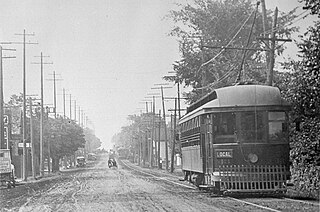
The Metropolitan line in the Toronto area, operated by the Metropolitan Street Railway, started out as a local horsecar line and transformed itself into an electric radial line extending to Lake Simcoe, following an old stage coach route. In 1904, the railway was acquired by the Toronto and York Radial Railway (T&YRR) and became the T&YRR Metropolitan Division. In 1922, the City of Toronto acquired the T&YRR and contracted Ontario Hydro to manage the four T&YRR lines including the Metropolitan. In 1927, the TTC took over the operation of the Metropolitan Line to Sutton, and renamed it the Lake Simcoe line. In 1930, the TTC closed the Metropolitan Line but shortly reopened the portion between Glen Echo and Richmond Hill operating it as the North Yonge Railways until 1948.

The North Yonge Railways was a radial railway line operated by the Toronto Transportation Commission from 1930 to 1948 between Glen Echo (Toronto) and Richmond Hill. The line was created by reopening the southern portion of the TTC's Lake Simcoe radial line that had closed in 1930.

Hydro One Limited is an electricity transmission and distribution utility serving the Canadian province of Ontario. Hydro One traces its history to the early 20th century and the establishment of the Hydro-Electric Power Commission of Ontario. In October 1998, the provincial legislature passed the Energy Competition Act which restructured Ontario Hydro into separate entities responsible for electrical generation, transmission/delivery, and price management with a final goal of total privatization.
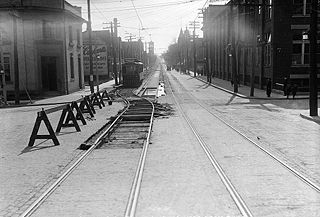
The history of public transportation in Toronto in Canada dates back to the middle 19th century under many different private companies, organizations and owners, which were all later unified as a single government-run entity during the 1920s.

The electricity sector in Canada has played a significant role in the economic and political life of the country since the late 19th century. The sector is organized along provincial and territorial lines. In a majority of provinces, large government-owned integrated public utilities play a leading role in the generation, transmission, and distribution of electricity. Ontario and Alberta have created electricity markets in the last decade to increase investment and competition in this sector of the economy.

A regional transmission organization (RTO) in the United States is an electric power transmission system operator (TSO) that coordinates, controls, and monitors a multi-state electric grid. The transfer of electricity between states is considered interstate commerce, and electric grids spanning multiple states are therefore regulated by the Federal Energy Regulatory Commission (FERC). The voluntary creation of RTOs was initiated by FERC in December 1999. The purpose of the RTO is to promote economic efficiency, reliability, and non-discriminatory practices while reducing government oversight.
Nova Scotia Power Inc. is a vertically integrated electric utility in Nova Scotia, Canada. It is privately owned by Emera and regulated by the provincial government via the Nova Scotia Utility and Review Board (NSUARB). Nova Scotia Power Inc provides electricity to 520,000 residential, commercial and industrial customers in Nova Scotia.

Toronto Hydro Corporation is an electric utility that operates the electricity distribution system for the city of Toronto, Ontario, Canada. As of 2018, it serves approximately 772,000 customers and delivers approximately 19% of the electricity consumed in Ontario.
The South of Scotland Electricity Board (SSEB) generated, transmitted and distributed electricity throughout the south of Scotland, including the former regions of Strathclyde, Lothian, Fife, Central, Borders and Dumfries and Galloway and a few towns in northern England. It operated from 1955 to 1991.

Toronto and Scarboro' Electric Railway, Light and Power Company was established in August 1892 to provide street railway service to the Upper Beaches district within the City of Toronto, Ontario and to the neighbouring Township of Scarborough. Except for two branches, the line ran as a radial along Kingston Road.
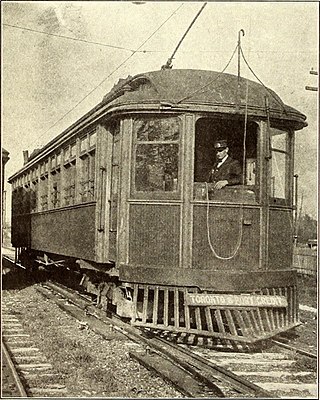
The Toronto and Mimico Electric Railway and Light Company was incorporated in 1890, and operated the Mimico radial line in the Toronto area. The line started operation in 1892 as a short suburban line that later was extended to Port Credit. In 1904, the railway was acquired by the Toronto and York Radial Railway (T&YRR) and became the T&YRR Mimico Division. In 1922, the City of Toronto acquired the T&YRR and contracted Ontario Hydro to manage the four T&YRR lines including the Mimico line. In 1927, the TTC took over the operation of the Mimico line and extended its service eastward to Roncesvalles Avenue. In 1928, the TTC double-tracked the line from Humber to Long Branch and made that portion part of the Lake Shore streetcar line. The portion beyond Long Branch to Port Credit became the Port Credit line, and continued operation as a single-track radial line until its closure on February 9, 1935.
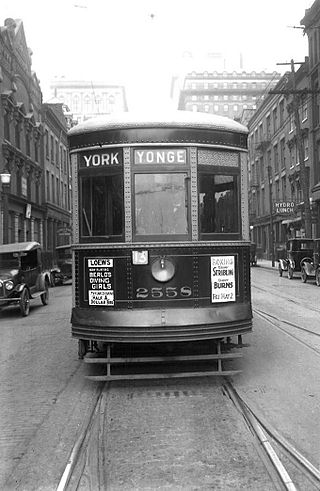
David William Harvey, B.A.Sc., M.E.I.C. was a Canadian engineer and transportation manager. He was a key player in the early development of the Toronto Transportation Commission and served as the transit operator's second General Manager, from 1924 until his death in 1938.
John Gordon Inglis B.A.Sc. was a Canadian electrical engineer and transit manager.
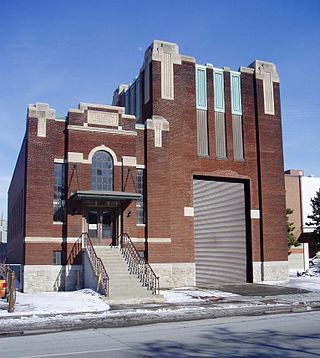
Hydro Ottawa Limited is a regulated electricity distribution company operating in the City of Ottawa and the Village of Casselman in Ontario, Canada. As the third-largest municipally owned electrical utility in Ontario, Hydro Ottawa maintains the electricity distribution systems in the city, and serves over 335,000 residential and commercial customers across a service area of 1,100 square kilometres.

The history of electricity sector in Canada has played a significant role in the economic and political life of the country since wide-scale industrial and commercial power services spread across the country in the 1880s. The development of hydropower in the early 20th century has profoundly affected the economy and the political life in Canada and has come to symbolize the transition from "old " industrialism of the 19th century to a "new", modern and diversified, Canadian economy.
















